
1:72 Lockheed P-74A, "Charger" (s/n 44-64148) of USAAF 310th FS/58th FG, 5th Air Force; based at Clark Field (Philippines), April 1945 (Whif/kit conversion) by
dizzyfugu, on Flickr

1:72 Lockheed P-74A, "Charger" (s/n 44-64148) of USAAF 310th FS/58th FG, 5th Air Force; based at Clark Field (Philippines), April 1945 (Whif/kit conversion) by
dizzyfugu, on Flickr
Some background:The P-74 "Charger" was a fighter aircraft built by Lockheed for the United States Army Air Forces (USAAF). Its configuration was unusual as it was designed as a twin boom pusher configuration, where the propeller is mounted in the rear of the fuselage, pushing the aircraft forward.
The P-74 entered service with the USAAF in late 1944, its conception dated back to 1939 when the U.S. Army Air Corps requested with the Circular Proposal R40C domestic manufacturers to develop high performance fighter types, allowing (even demanding) unusual configurations. Lockheed did not respond immediately and missed the chance to sign a development contract in mid-1940 until early 1941. Twenty-three proposals were submitted to R40C, and after a fist selection of ideas three companies, Vultee with the large XP-54 Swoose Goose, Curtiss with its XP-55 Ascender and Northrop's XP-56 Black Bullet were able to secure prototype contracts.
 1:72 Lockheed P-74A, "Charger" (s/n 44-64148) of USAAF 310th FS/58th FG, 5th Air Force; based at Clark Field (Philippines), April 1945 (Whif/kit conversion) by dizzyfugu, on Flickr
1:72 Lockheed P-74A, "Charger" (s/n 44-64148) of USAAF 310th FS/58th FG, 5th Air Force; based at Clark Field (Philippines), April 1945 (Whif/kit conversion) by dizzyfugu, on Flickr
1:72 Lockheed P-74A, "Charger" (s/n 44-64148) of USAAF 310th FS/58th FG, 5th Air Force; based at Clark Field (Philippines), April 1945 (Whif/kit conversion)[/url] by dizzyfugu, on Flickr
Vultee eventually won the competition, but all these innovative new aircraft suffered from various flaws or development delays, missing various performance goals, so that none ever entered service.
In the meantime, Lockheed had been working on the 1939 request in the background on a private venture basis, as it was clear that by 1944 a successor to the company's own P-38 Lightning had to be offered to the USAAC.
The new North American P-51 Mustang was also a sharp competitor, esp. for the Pacific conflict theatre where long range was needed. This role was filled out very well by the P-38, but it was a relatively large and complicated aircraft, so an alternative with a single engine was strived for. Even though jet engines already showed their potential, it was clear that the requested range for the new type could only be achieved through a piston engine.
1:72 Lockheed P-74A, "Charger" (s/n 44-64148) of USAAF 310th FS/58th FG, 5th Air Force; based at Clark Field (Philippines), April 1945 (Whif/kit conversion)[/url] by dizzyfugu, on Flickr
1:72 Lockheed P-74A, "Charger" (s/n 44-64148) of USAAF 310th FS/58th FG, 5th Air Force; based at Clark Field (Philippines), April 1945 (Whif/kit conversion)[/url] by dizzyfugu, on Flickr
 1:72 Lockheed P-74A, "Charger" (s/n 44-64148) of USAAF 310th FS/58th FG, 5th Air Force; based at Clark Field (Philippines), April 1945 (Whif/kit conversion) by dizzyfugu, on Flickr
1:72 Lockheed P-74A, "Charger" (s/n 44-64148) of USAAF 310th FS/58th FG, 5th Air Force; based at Clark Field (Philippines), April 1945 (Whif/kit conversion) by dizzyfugu, on Flickr
This aircraft became the XP-74, originally christened “Laelaps”, following Lockheed’s tradition, after a female Greek mythological dog who never failed to catch what she was hunting. It was presented as a mock-up to USAAC officials on August 8th 1942 and immediately found sponsorship: with the disappointing results from the XP-54,55 and 56 was immediately ushered into the prototype stage. Its name, though, was rejected, and the more common name “Charger” was adopted.
Just like Lockheed’s successful P-38 the XP-74 Charger was designed as a twin-boom aircraft, but it was driven by only a single Packard (License-built Rolls Royce Merlin) V-1650 pusher engine in the aft part of the fuselage. The tail was mounted rearward between two mid-wing booms, with a four-bladed 12-ft propeller between them. The design also included a "ducted wing section" developed by the NACA that enabled installation of cooling radiators and intercoolers in the wing root section.
 1:72 Lockheed P-74A, "Charger" (s/n 44-64148) of USAAF 310th FS/58th FG, 5th Air Force; based at Clark Field (Philippines), April 1945 (Whif/kit conversion) by dizzyfugu, on Flickr
1:72 Lockheed P-74A, "Charger" (s/n 44-64148) of USAAF 310th FS/58th FG, 5th Air Force; based at Clark Field (Philippines), April 1945 (Whif/kit conversion) by dizzyfugu, on Flickr
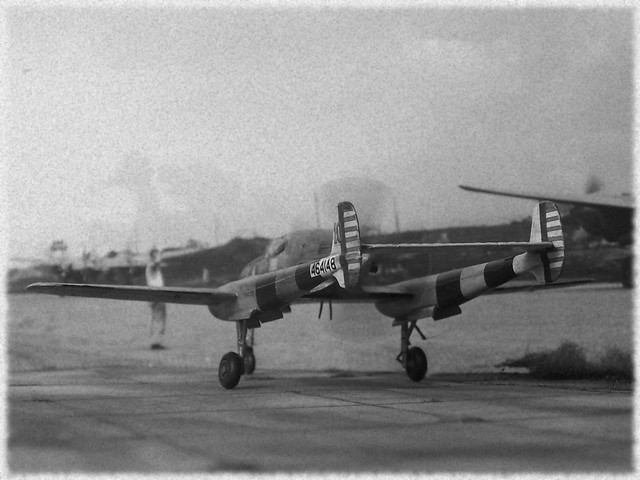 1:72 Lockheed P-74A, "Charger" (s/n 44-64148) of USAAF 310th FS/58th FG, 5th Air Force; based at Clark Field (Philippines), April 1945 (Whif/kit conversion) by dizzyfugu, on Flickr
1:72 Lockheed P-74A, "Charger" (s/n 44-64148) of USAAF 310th FS/58th FG, 5th Air Force; based at Clark Field (Philippines), April 1945 (Whif/kit conversion) by dizzyfugu, on Flickr
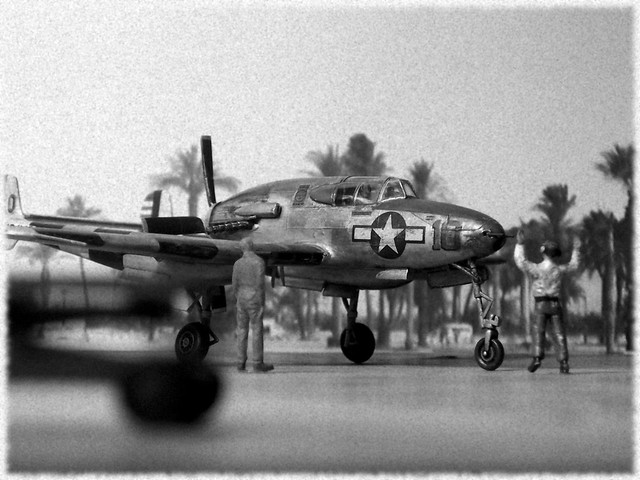 1:72 Lockheed P-74A, "Charger" (s/n 44-64148) of USAAF 310th FS/58th FG, 5th Air Force; based at Clark Field (Philippines), April 1945 (Whif/kit conversion) by dizzyfugu, on Flickr
1:72 Lockheed P-74A, "Charger" (s/n 44-64148) of USAAF 310th FS/58th FG, 5th Air Force; based at Clark Field (Philippines), April 1945 (Whif/kit conversion) by dizzyfugu, on Flickr
The advantages of a pusher design are that the view forward is unobstructed and armament can be concentrated in the nose, while a major drawback is difficulty in escaping from the aircraft in an emergency, as the pilot could get drawn into the propeller blades. Lockheed deliberated between systems that would eject the pilot, or jettison the propeller or the engine, via a system of explosive bolts. Lockheed eventually installed an early ejector seat which was driven by pressurized air, combined with a mechanism that would blow the canopy off. The system was successfully tested in summer 1943, even though skepticism remained among pilots.
Initial armament comprised one 20mm Hispano cannon and four 12.7mm Browning machine guns, the same as in the P-38, but two machine guns were relocated from the nose into the front ends of the tail booms because of the new aircraft’s smaller overall dimensions.
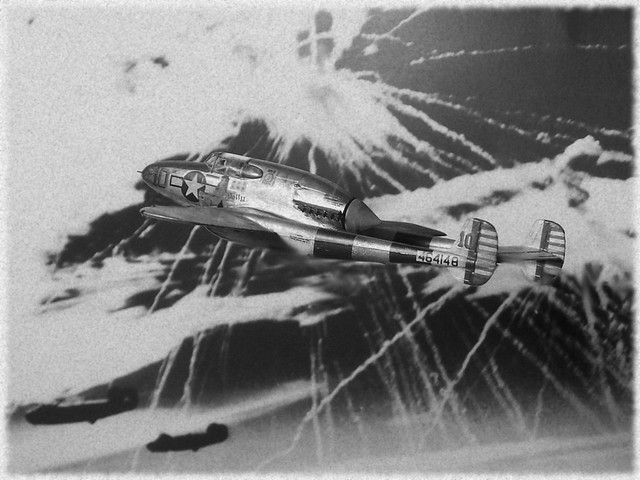 1:72 Lockheed P-74A, "Charger" (s/n 44-64148) of USAAF 310th FS/58th FG, 5th Air Force; based at Clark Field (Philippines), April 1945 (Whif/kit conversion) by dizzyfugu, on Flickr
1:72 Lockheed P-74A, "Charger" (s/n 44-64148) of USAAF 310th FS/58th FG, 5th Air Force; based at Clark Field (Philippines), April 1945 (Whif/kit conversion) by dizzyfugu, on Flickr
 1:72 Lockheed P-74A, "Charger" (s/n 44-64148) of USAAF 310th FS/58th FG, 5th Air Force; based at Clark Field (Philippines), April 1945 (Whif/kit conversion) by dizzyfugu, on Flickr
1:72 Lockheed P-74A, "Charger" (s/n 44-64148) of USAAF 310th FS/58th FG, 5th Air Force; based at Clark Field (Philippines), April 1945 (Whif/kit conversion) by dizzyfugu, on Flickr
 1:72 Lockheed P-74A, "Charger" (s/n 44-64148) of USAAF 310th FS/58th FG, 5th Air Force; based at Clark Field (Philippines), April 1945 (Whif/kit conversion) by dizzyfugu, on Flickr
1:72 Lockheed P-74A, "Charger" (s/n 44-64148) of USAAF 310th FS/58th FG, 5th Air Force; based at Clark Field (Philippines), April 1945 (Whif/kit conversion) by dizzyfugu, on Flickr
The first prototype was ready in October 1943, with a different engine and heavier armor fitted. The second prototype was built to this specification from the start, which would become the serial production standard, the P-74A.
The P-74A used the new V-1650-9 engine, a version of the Merlin that included Simmons automatic supercharger boost control with water injection, allowing War Emergency Power as high as 2,218 hp (1,500 kW). Another change concerned the armament: a longer weapon range was deemed necessary, so the gun armament was changed into four 20mm Hispano cannons, two of the placed in the fuselage nose and one in each tail boom front end. Each gun was supplied with 250 RPG.
Alternatively, a nose installment with a single 37mm cannon and two 12.7mm Browning MGs was tested on the first prototype, but this arrangement was found to be less effective than the four 20mm cannons. Another factor that turned this option down was the more complicated logistics demands for three different calibers in one aircraft.
 1:72 Lockheed P-74A, "Charger" (s/n 44-64148) of USAAF 310th FS/58th FG, 5th Air Force; based at Clark Field (Philippines), April 1945 (Whif/kit conversion) by dizzyfugu, on Flickr
1:72 Lockheed P-74A, "Charger" (s/n 44-64148) of USAAF 310th FS/58th FG, 5th Air Force; based at Clark Field (Philippines), April 1945 (Whif/kit conversion) by dizzyfugu, on Flickr
 1:72 Lockheed P-74A, "Charger" (s/n 44-64148) of USAAF 310th FS/58th FG, 5th Air Force; based at Clark Field (Philippines), April 1945 (Whif/kit conversion) by dizzyfugu, on Flickr
1:72 Lockheed P-74A, "Charger" (s/n 44-64148) of USAAF 310th FS/58th FG, 5th Air Force; based at Clark Field (Philippines), April 1945 (Whif/kit conversion) by dizzyfugu, on Flickr
The P-74A was ready for service in summer 1944, but its deployment into the Pacific region took until December – the 5th Air Force first units replaced most of its P-38 and also early P-47Ds with the P-74A.These new aircraft had their first clashes with Japanese forces in January 1945.
The P-74 was used in a variety of roles. It was designed as an intreceptor against bombers, but its good range and handling at all altitudes made it suitable for tasks like fighter sweeps against enemy airfields, support for U.S. ground forces and protection of sea convoys and transport routes.
While the P-74 could not out-turn the A6M Zero and most other Japanese fighters when flying below 200 mph (320 km/h), its superior speed coupled with a good rate of climb meant that it could utilize energy tactics, making multiple high-speed passes at its target. Also, its focused firepower was deadly to lightly armored Japanese warplanes.
 1:72 Lockheed P-74A, "Charger" (s/n 44-64148) of USAAF 310th FS/58th FG, 5th Air Force; based at Clark Field (Philippines), April 1945 (Whif/kit conversion) by dizzyfugu, on Flickr
1:72 Lockheed P-74A, "Charger" (s/n 44-64148) of USAAF 310th FS/58th FG, 5th Air Force; based at Clark Field (Philippines), April 1945 (Whif/kit conversion) by dizzyfugu, on Flickr
 1:72 Lockheed P-74A, "Charger" (s/n 44-64148) of USAAF 310th FS/58th FG, 5th Air Force; based at Clark Field (Philippines), April 1945 (Whif/kit conversion) by dizzyfugu, on Flickr
1:72 Lockheed P-74A, "Charger" (s/n 44-64148) of USAAF 310th FS/58th FG, 5th Air Force; based at Clark Field (Philippines), April 1945 (Whif/kit conversion) by dizzyfugu, on Flickr
Because of its late service introduction, only 305 P-74s were ever produced until the end of hostilities, and they were exclusively used in the Pacific theatre. The P-74's service record shows mixed results, but usually because of misinformation. P-74s have been described as being harder to fly than traditional, single-engined aircraft, but this was because of inadequate training in the first few months of service.
Another drawback was the ejection seat system – it worked basically well, but the tank for the pressurized air turned out to be very vulnerable to enemy fire. Several P-74s literally exploded in midair after cannon fire hits, and this poeblem could only be cured when the tank section behind the cockpit received a more rigid structure and additional armor. Anyway, the P-74 was quickly retired after WWII, as the USAAF focussed on P-47 and P-51.
 1:72 Lockheed P-74A, "Charger" (s/n 44-64148) of USAAF 310th FS/58th FG, 5th Air Force; based at Clark Field (Philippines), April 1945 (Whif/kit conversion) by dizzyfugu, on Flickr
1:72 Lockheed P-74A, "Charger" (s/n 44-64148) of USAAF 310th FS/58th FG, 5th Air Force; based at Clark Field (Philippines), April 1945 (Whif/kit conversion) by dizzyfugu, on Flickr
 1:72 Lockheed P-74A, "Charger" (s/n 44-64148) of USAAF 310th FS/58th FG, 5th Air Force; based at Clark Field (Philippines), April 1945 (Whif/kit conversion) by dizzyfugu, on Flickr
1:72 Lockheed P-74A, "Charger" (s/n 44-64148) of USAAF 310th FS/58th FG, 5th Air Force; based at Clark Field (Philippines), April 1945 (Whif/kit conversion) by dizzyfugu, on Flickr
General characteristics Crew: 1
Length: 10.45 m (34 ft 3 in)
Wingspan: 11.6 m (38 ft 0 in)
Height: 3.97 (13 ft 0 in)
Wing area: 22.2 m² (238.87 ft²)
Empty weight: 3,250 kg (7,165 lb)
Loaded weight: 4,150 kg (9,149 lb)
Max. take-off weight: 4,413 kg (9,730 lb)
Powerplant: 1× Packard (License-built Rolls Royce Merlin) V-1650-9 ,
rated at 1,380 hp (1,030 kW) and 2,218 hp (1,500 kW) w. water injection
Performance Maximum speed: 640 km/h (343 knots, 398 mph)
Cruise speed: 495 km/h (265 knots, 308 mph)
Range: 1,105 mi (1,778 km)
Ferry range: 1,330 nmi (1,530 mi, 2,460 km)
Service ceiling: 11,000 m (36,090 ft)
Rate of climb: 15 m/s (2,950 ft/min)
Armament 4× 20 mm (0.79 in) Hispano-Suiza HS.404 cannons with 250 RPG
2× hardpoints for up to 2,000 lb (907 kg) of bombs, 6 or 10× T64 5.0 in (127 mm) H.V.A.R rockets
Ein relativ einfaches Whif - mehr oder weniger schlichte Travestie, denn dies ist eine Saab J21 in ungewöhnlicher Optik. Inspiration war eine ähnliche Computergrafik, verm. aus einem Flugsimulator - und ich fand, dass das blanke Alu der Saab sehr gut stünde! Also ein Whif gebaut...

Der Bausatz ist von Heller, und für sein Alter sehr anständig. Es wurde wenig umgebaut, z. B. ein neuer Vierblattpropeller, ein Pilot sowie neue Hauptfahrwerksbeine, gescratcht aus Elementen von einer A-1 und P-51.
Anstrich ist primär mit dem sehr m.E. guten Humbrol-metallizer "Polished Alu" gemacht, ein paar Kontratsflächen sind aber auch mit Stahl-Metallizer, Alu-Metallic und einfachem Silber gesetzt, und zum Schluß kam noch etwas geriebenes Garphit drüber, das die erhabenen Panel-Lines betont und nochmal einen verwitterten Eindruck macht. Überhaupt ging es darum, die Kiste nicht unbedingt bunt zu machen, aber mit vielen Kontrasten zu arbeiten - eben mit den schwarzen ID-Bändern (alles Aufkleber, manuell aus den Vollen geschnitten), das weiße Leitwerk mit den Vorkriegs-Streifen, das grüne Cockpit und die Chromgelben Fahrwerksschächte.
Die Abzeichen und Markierungen sind einem realen Vorbild nachempfunden - diese Zirkusoptik flog tatsächlich im Pazifik, auf P-47D Thunderbolts, ich habe versucht ein entprechendes Vorbild nachzuempfinden. Das Nose-Art-Pin-Up hat im Original übrigens eine tschechische MiG-21 (Pardubice 1989) geschmückt!

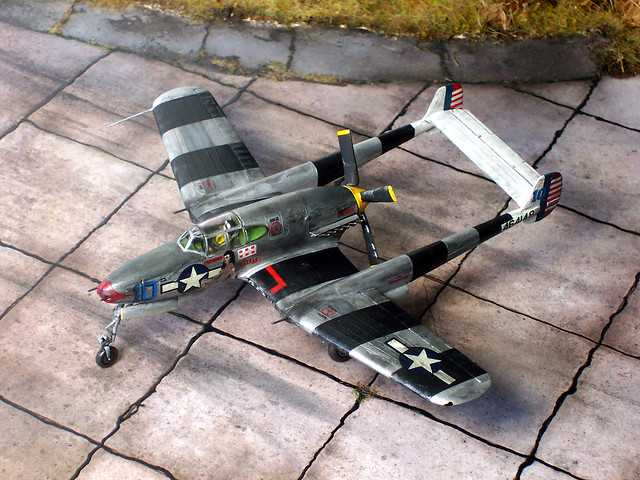
1:72 Lockheed P-74A, "Charger" (s/n 44-64148) of USAAF 310th FS/58th FG, 5th Air Force; based at Clark Field (Philippines), April 1945 (Whif/kit conversion) by
dizzyfugu, on Flickr

1:72 Lockheed P-74A, "Charger" (s/n 44-64148) of USAAF 310th FS/58th FG, 5th Air Force; based at Clark Field (Philippines), April 1945 (Whif/kit conversion) by
dizzyfugu, on Flickr
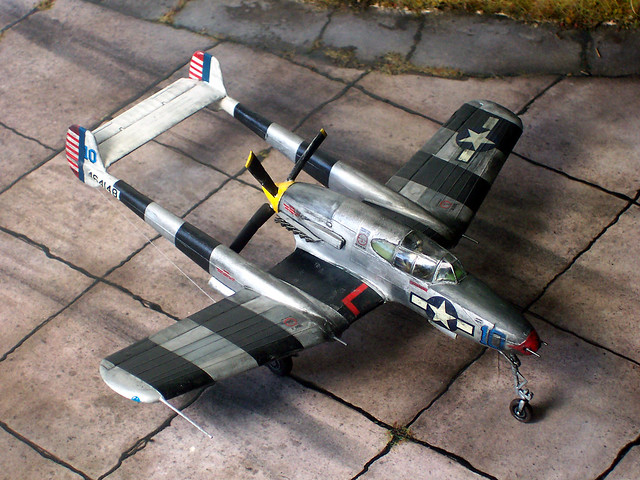
1:72 Lockheed P-74A, "Charger" (s/n 44-64148) of USAAF 310th FS/58th FG, 5th Air Force; based at Clark Field (Philippines), April 1945 (Whif/kit conversion) by
dizzyfugu, on Flickr